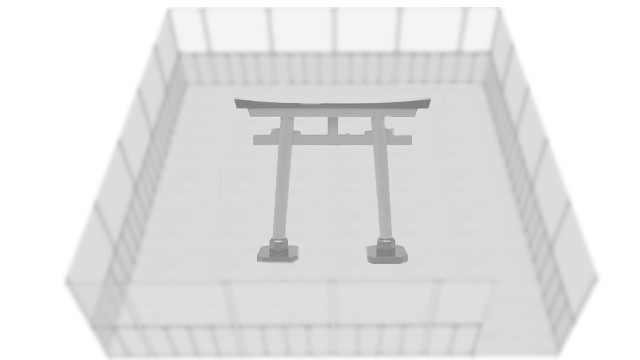
La composición de un DojoThe layout of a DojoLa distribuzione di un Dojo
En este artículo intentaremos hacer una breve descripción de la distribución de un dojo, aunque antes os invito a probar este sencillo juego.
En primer lugar, y por orden de importancia, tenemos lo que en occidente se denomina comúnmente shomen, pero es también término equivalente el de “shinzen”. Éste ha de estar situado en el extremo opuesto al de la puerta de entrada al dojo. Aquí es donde ha de colocarse, en su caso, el “kamidana” o santuario sintoísta. El shomen es el punto de mayor excelencia o supremacía en el dojo. Si vemos películas japonesas de época, o jidaigeki, observamos que aquí es donde se posiciona el tonosama. Trasladando este mismo concepto al kendo, en el caso de eventos o campeonatos, aquí se sitúa el palco de honor donde se sentarán entre otros los miembros de la familia real o imperial.
Por otro lado, encontramos el kamiza (o “jouseki”). A este respecto hemos de puntualizar para aquellos que tengan nociones de japonés que el término kamiza nada tiene que ver con kamisama o “divinidad”, sino que los caracteres que lo componen significan literalmente “asiento de arriba”. Es un término utilizado también en el japonés cotidiano, y es el lugar donde ha de sentarse la persona “de mayor grado”. En el Japón diario existe un complejo sistema en torno a cuál ha de considerarse este sitio, según el tipo de sala o ubicación, y los elementos que lo rodean (de lo que espero poder hablar en algún artículo offtopic). Aplicado al Kendo, y como casi todos habréis deducido, éste es el lugar donde se sientan los senseis, y normalmente se refiere al lado derecho del shomen, siendo que el de mayor grado es el más cercano a éste, y el resto ha de situarse de forma que el de menor grado quede más alejado de dicho shomen.
Un apunte curioso por si alguno también se ha hecho la pregunta: “¿por qué los senseis no se sientan en el lado del shomen?”. La respuesta es que de ser así, sería del todo irrespetuoso enseñar el trasero a la referida divinidad, e igualmente no sería correcto dar la espalda a los invitados de honor.
Por último, y en contraposición a este concepto de kamiza está el de “shimoza”, que es el lugar donde ha de situarse la persona que en ese momento tenga menor grado, y correspondería al sitio más alejado al shomen.
Esta sería grosso modo la distribución de un dojo, pero estas normas genéricas pueden variar para adaptarse a la situación y características de cada lugar. Como siempre, lo importante es adaptarse a las reglas existentes en cada lugar, y en ningún caso querer imponer lo que nosotros creemos que es correcto.
En otro artículo profundizaremos un poco sobre la idea de kamiza y con qué espíritu ha de uno sentarse en él.
In this article we will give a brief description of the layout of a dojo, but before that, we challenge you to try this simple game.
First, and in order of importance, we have what is commonly known in the West as shomen, but it is also equivalent to the term “shinzen“. This has to be located at the opposite end of the entrance door of the dojo. Here is where,if the case, the “ kamidana ” or Shinto shrine is to be placed. It is the spot of greatest excellence or supremacy in the dojo. If we see vintage Japanese films, or jidaigeki, we would see that this is where the Tonosama is placed. Bringing this concept to kendo, in the case of events or championships, here stands the Royal Box, among other members of the royal or imperial family will be seated.
On the other hand, we find the kamiza (or “jouseki“). In this regard we will point out for those who may have certain Japanese language notions that the term kamizahas nothing to do with kamisama or “divinity”, but the characters that compose this word mean literally “seat up”. It is a term also used in the Japanese daily life, and it refers to where the “higher grade” person has to be sit. In Japanese daily life there is a complex system about where exactly this place is situated, depending on the type of room or location and the surrounding elements (of what I hope to talk in some offtopic article). Applied to Kendo, and as most of you will have guessed, this is the place where the sensei sits, and it usually refers to right side of the shomen, where the highest grade is located closest to it, and the rest of them are positioned so that the lower grade is in the furthest place from the shomen.
An interesting point, in case anyone has also wondered: “Why do the senseis do not sit on the side of shomen?”. The answer is that if so, it would be entirely disrespectful to show one’s back to the divinity, and equally it would be wrong to turn away from the guests of honor.
Finally, and in contrast to this concept of kamiza is the “shimoza”, which is the place where the person with the lesser degree at that time shall situate, and it corresponds to the farthest spot from the shomen.
This would be roughly the distribution of a dojo, but these general rules can vary to suit the situation and characteristics of each place. As always, what is important is to adapt to the rules existing in each place, and in no case want to impose what we believe is right.
In another article delve a little about the idea of kamiza and in what spirit one has to sit on it.



Muy interesante! Yo era de los que erróneamente relacionaba el kamiza con el concepto de kamisama. Gracias sho-chan.